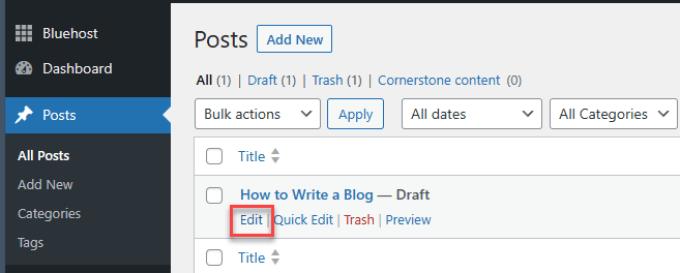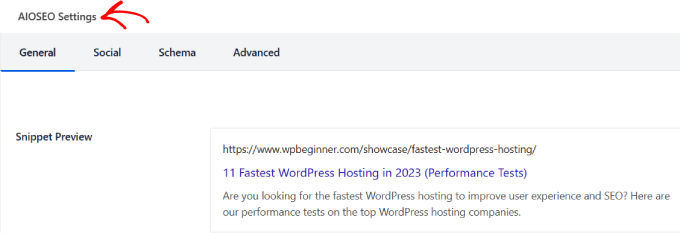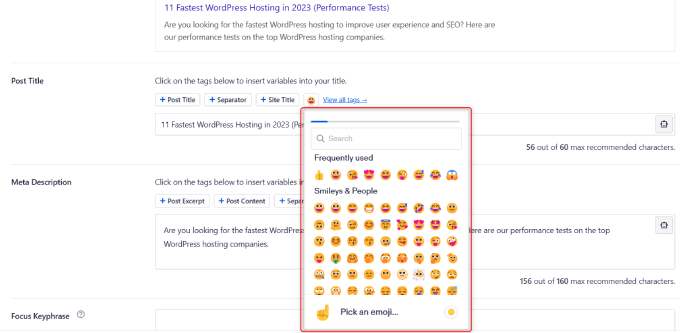Web sitenizin Google arama sonuçlarında öne çıkmasını ister misiniz?
SEO başlıklarınıza emoji eklemek, dikkat çekmenin ve daha fazla tıklama almanın basit bir yoludur. WPBeginner'da, başlıklarımızın arama sayfalarının düz beyaz arka planına karşı öne çıkmasını sağlamak için onları kullanıyoruz.
Bu kılavuzda, WordPress'te SEO başlığınıza kolayca nasıl emoji ekleyeceğinizi göstereceğim.

SEO Başlıklarınıza Neden Emoji Eklemelisiniz?
Emojiler, duyguları, nesneleri, etkinlikleri ve diğer kavramları iletmek için kullanılan küçük dijital simgelerdir. Metnin yerini alabilir veya mesaja daha fazla anlam katarak onu zenginleştirebilirler.
Kelimelerle dolu bir sayfada, renkli ve parlak emojiler sayfanızın öne çıkmasına yardımcı olur.
Emojiler kullanarak sayfanıza dikkat çekersiniz ve markanızın daha insancıl görünmesini sağlarsınız, hedef kitlenizi çekersiniz ve tıklama oranlarını artırırsınız.
CTR'nizi artırmak Google'da daha iyi sıralama almanızı garanti etmese de, web sitenize daha fazla trafik çekmek her zaman iyi bir şeydir.
Tek sebep bu değil. Arama motorları emojilerle yapılan arama sorgularını da destekler. Google'ın arama çubuğuna ‘🍕recipe’ yazmayı deneyin.

Arama sonuçlarında ‘🍕’ emojisini içeren sonuçlar bulacaksınız çünkü Google, arama sorgusundaki emojiyi tanır ve bu belirli içeriğe uyan sayfaları arar.
SEO Başlıklarınızda Emojileri Kullanma
Emojiler, yanıltıcı veya spam olarak algılanırlarsa tıklama oranlarınızı ve SEO'nuzu olumsuz etkileyebilir.
Başlıklarınıza emoji eklemeye başlamadan önce, uymanız gereken bazı temel kurallar vardır:
- Hedef kitlenizi düşünün: Emjiler bazı nişlerde diğerlerinden daha iyi çalışır. Örneğin, yaz aylarında yapılabilecek en iyi kokteyller için bir tarif sayfasında emji kullanmak uygun olabilir. Ancak, sağlık hizmetleriyle ilgili bir sayfaya kalp veya şırınga eklemek markanızın itibarını zedeleyebilir.
- Kelime yerine emoji kullanmayın: Emojiler ne kadar net veya açıklayıcı olursa olsun, kelimelerin yerine asla kullanılmamalıdır çünkü kullanıcılar emojinin anlamını yorumlamak zorunda kalır, kendilerine söylenmesi yerine.
- Net emojiler kullanın: İnsanların yanlış anlayabileceği belirsiz emojilerden kaçının. Bunun yerine, tüm kitleler tarafından yaygın olarak bilinen basit olanlara bağlı kalın.
- Hem açık hem de koyu arka planlarda çalışan emojiler kullanın: Açık arka planlarda açık renkli emojiler kullanmaktan kaçının. Örneğin, sarı bir el emojisi, beyaz bir el emojisinden ziyade açık arka planlarda daha iyi çalışır. Bu, Google'ın varsayılan sonuç arka planı düz beyaz olduğu için SEO başlıkları için özellikle önemlidir.
Emojileri sorumlu bir şekilde nasıl kullanacağınızı artık bildiğinize göre, web sayfalarınızda kullanmaya başlayabilirsiniz.
İşte adım adım rehber.
SEO Başlıklarınıza Emoji Nasıl Eklenir
İyi bir eklentiniz olduğunda başlıklarınıza emoji eklemek inanılmaz derecede kolaydır. Olmadan, emojileri başka bir web sitesinden bulmak ve kopyalamak için gönderi düzenleyicinizden ayrılmanız gerekebilir, bu da iş akışınızı bozar.
SEO başlıklarınıza emoji eklemenin ilk adımı, ücretsiz All in One SEO eklentisini kullanmaktır.
AIOSEO, bloglarınızı arama sonuçlarında daha üst sıralarda yer alacak şekilde optimize etmeniz için sayfa içi analiz sunar. Ayrıca yerleşik emoji seçiciyi kullanarak SEO başlıklarınıza emojiler ekleyebilirsiniz.
AIOSEO ayrıca web sitenizi optimize etmenize ve sıralamalarınızı artırmanıza yardımcı olabilecek bir SEO kontrol listesi aracı, bir bağlantı asistanı ve daha birçok özellik ile birlikte gelir.
Son birkaç yıldır, sitemizin SEO'sunu iyileştirmek için bu eklentiyi kullanıyoruz ve o zamandan beri hem sıralamalarımızda hem de trafiğimizde belirgin bir artış gördük. Deneyimlerimiz hakkında daha fazla bilgi edinmek için AIOSEO incelememize bakın.
AIOSEO eklentisini yükleyerek başlayın. Daha fazla ayrıntı için, bir WordPress eklentisinin nasıl kurulacağına dair adım adım kılavuzumuzu takip edebilirsiniz.
İşlem tamamlandıktan sonra, blog yazılarınızı ve sayfalarınızı düzenlemeye ve SEO başlığınıza emji eklemeye hazırsınız.
SEO Başlığınızı Düzenleyin
AIOSEO eklentisi ile meta verilerinizi optimize etmek çok kolay. WordPress yönetici kontrol panelinin sol menüsünden Gönderiler'i seçin.
Bunu WordPress blogunuzdaki sayfalar için de yapabilirsiniz, ancak bu öğretici için sadece bir gönderiyi örnek olarak düzenleyeceğiz.
Güncellemek istediğiniz blog yazısını bulun. Ardından 'Düzenle' bağlantısına tıklayın. Hem Blok hem de Klasik düzenleyiciler etkinse, ikisi de işe yarayacaktır.

'AIOSEO Ayarları' sekmesine ulaşana kadar WordPress içerik düzenleyicisinde aşağı kaydırmanız yeterlidir.
Oradan, gönderi başlığı alanını düzenleyebilirsiniz.

Emojinizi Seçin ve Ekleyin
Şimdi, metadatanıza emojinizi eklemeye hazırsınız. Bunu yapmak için, AIOSEO Ayarları'nın biraz altında aşağı kaydırın.
Yazı Başlığı altında, her alandaki etiketlerin yanındaki emoji simgesine tıklayın.

Seçebileceğiniz emojilerin bir listesini içeren bir pencere açacaktır.
Göz atın ve istediğiniz emojileri ekleyin veya aradığınızı bulmak için arama çubuğunu kullanın.

Son olarak, 'Güncelle/Yayınla' düğmesine bastığınızdan emin olun.
Bundan sonra, emoji SEO başlığında görünecek ve arama sonuçlarında görüntülenecektir.

Şimdi, seçtiğiniz emjiyi seçin ve hepsi bu kadar! Tebrikler, SEO başlığınıza emji eklediniz.
Sıkça Sorulan Sorular WordPress'te Emji Kullanımı Hakkında
Artık SEO başlıklarınıza nasıl emoji ekleyeceğinizi bildiğinize göre, WordPress web sitenizi geliştirmek için ifadeleri etkili bir şekilde nasıl kullanacağınıza dair birkaç sorunuz olabilir.
HTML Başlıklarına Emji Nasıl Eklenir?
Geçmişte, HTML'ye emoji eklemek için özel kodlara ihtiyacınız vardı. Ancak, modern web siteleri, emojiyi doğrudan başlık etiketinin içine yapıştırmanıza olanak tanıyan karakter kodlaması kullanır. Bununla birlikte, WordPress kullanıcıları için bir SEO eklentisi kullanmak hala en güvenli ve en kolay yöntemdir.
Emojiler SEO'yu Etkiler mi?
Google, SEO sayfalarınızda başlıklar dahil emojileri kullanabileceğinizi söylüyor, ancak bu arama sıralamalarınıza hiçbir şekilde yardımcı olmaz veya zarar vermez. Ancak, tıklama oranlarını iyileştirerek emojiler dolaylı olarak SEO çabalarınıza yardımcı olur.
Emojiler markanızı insancıllaştırabilir ve kullanıcılar sitenizde daha fazla zaman geçirirse veya içeriğinizle etkileşim kurarsa, bu sinyaller arama sıralamanızı yükseltebilir.
Emojiler Başlığın Önüne mi Sonuna mı Gelir?
Başlığın önüne emoji kullanmak, özellikle ekran okuyucu kullanan biri için kötü bir kullanıcı deneyimi sunabilir. Yazılım, gerçek başlığınızdan önce emojinin metin açıklamasını (örneğin, 'Pizza Dilimi') okuyacaktır, bu da kullanıcıları ana konudan uzaklaştırabilir.
WordPress bloguma nasıl emoji eklerim?
Windows için klavyenizde Windows + . (Nokta) kısayol tuşlarına basabilirsiniz. Mac için, ekranın üstündeki menü çubuğuna gidip Düzenle » Emoji ve Semboller'e tıklamanız yeterlidir.
Ek Kaynaklar
Umarım bu makale, WordPress SEO başlıklarınıza nasıl emoji ekleyeceğinizi öğrenmenize yardımcı olmuştur. Ayrıca bu ek kaynakları da okumak isteyebilirsiniz:
- Yeni Başlayanlar İçin Kapsamlı WordPress SEO Rehberi (Adım Adım)
- WordPress'te SEO Başlığı ve H1 Gönderi Başlığı: Fark Nedir?
- WordPress'te Organik Tıklama Oranını (CTR) Nasıl Artırırsınız
- WordPress'te Anahtar Kelimeler ve Meta Açıklamalar Nasıl Eklenir
- Kullanmanız Gereken En İyi WordPress SEO Eklentileri ve Araçları
- WordPress Eklentisi Nasıl Kurulur – Yeni Başlayanlar İçin Adım Adım
Bu makaleyi beğendiyseniz, lütfen WordPress video eğitimleri için YouTube Kanalımıza abone olun. Bizi ayrıca Twitter ve Facebook'ta da bulabilirsiniz.





Olaf
SEO başlıklarındaki emojiler dikkat çekme açısından ilginç olabilir, ancak dürüst olmak gerekirse, onları hiçbir yerde pek fark etmedim. Bunun nedeni Google'ın bu tekniği terk edip artık onları göstermemesi mi, yoksa ben mi böyle bir başlığa denk gelmek için yeterince şanslı değilim? Eğer hala kullanılıyorsa, başlık yazarken bu gerçek bir rekabet avantajı olabilir mi?
WPBeginner Desteği
From an SEO perspective Google does not give an advantage or disadvantage for using them, it would depend more on your target audience for if emojis work for you
Yönetici
kzain
Bu ilginç bir konsept! SEO başlıklarına emoji eklemeyi hiç düşünmemiştim. SEO'ya zarar vermeyeceklerini bilmek harika olsa da, artan tıklama oranları potansiyeli ilgi çekici. Emoji eklemeyi kolaylaştırmak için EmojiCopy web sitelerini kullanma fikri kullanışlı görünüyor.
Jiří Vaněk
Web siteme emoji eklemeyi denedim. SEO ne kötüleşti ne de iyileşti. Trafik ise aynı kaldı. Ancak fark ettiğim şey, Google'ın ara sıra SERP'te emojileri göstermesiydi, ama oldukça nadiren. Pratikte, başlıkta emoji olmasına rağmen Google'ın %90 oranında onları SERP'te göstermediğini gördüm. Nedenini anlamıyorum. Belki Google tarafında bir şeyler değişti ve emojileri görmezden gelip göstermemeye başladı.
mohadese esmaeeli
Klavyenizde pencere tuşuna ve nokta tuşuna aynı anda basın. Bir pencere açılacak ve buradan istediğiniz emojiyi seçebilirsiniz.
WPBeginner Desteği
For some cases that would work but if you are adding HTML you would want to use the unicode characters
Yönetici
Dennis Muthomi
Ben de o kısayolu kullanıyorum. Herhangi bir yere hızlıca emoji eklemek için süper kullanışlı.
Ancak fark ettiğim bir şey var ki, emoji tasarımları Windows, Android, Apple cihazları vb. arasında oldukça farklılık gösterebilir.
Jiří Vaněk
Bir süre sonra bu konuyu sormak istiyorum. AIO SEO kullanıyorum ve bazı makalelerin başlıklarına ifadeler eklemeye başladım. Ancak SERP sonuçlarına baktığımda ifadeleri göremiyorum. Orada değiller. Aynı şey meta açıklamasında da sık sık başıma geliyor, orada ifadeler var ama google'daki sonuç temelde tamamen farklı. Makalede yazılan her şey hala geçerli mi, yoksa Google sonuçların SERP'teki gösterimini bir şekilde değiştirdi ve artık ifadeleri göstermiyor mu? Başlıkta, makaleye tıkladığımda ifadeleri görüyorum. Google analytics'te de öyle, ama SERP'te değil.
WPBeginner Desteği
Şimdilik makalede yazdıklarımız hala doğru, Google başlıklarınızdaki emojiler konusunda her iki şekilde de umursamıyor. Arama motorları öncelikli olarak SERP'te emojiyi gösterip göstermeyecekleri konusunda seçici davranıyor.
Yönetici
Jiří Vaněk
Açıklama için teşekkürler. Beni şaşırtan şey, emoji ekliyordum ama Google'ın SERP'inde henüz görmemiş olmamdı. Ancak bu taktiği yaklaşık bir aydır kullanıyorum, göreceğiz.
Jiří Vaněk
Arama sonuçlarında bunu daha önce hiç fark etmemiştim. Belki de başlıklarında emojilerin pek bulunmadığı veya hiç bulunmadığı teknik şeyleri aramaya eğilimli olduğum içindir. Ancak, web sitesi SERP'te görünüyorsa tıklama oranlarını artırmak için ilginç bir yol. Dahası, belirttiğiniz gibi SEO'yu olumsuz etkilemiyorsa, emojileri çekici bulan bir kitleye hitap eden web siteleri için ilgi çekici bir seçenek olabilir.
Ralph
Eşim bir tarif blogu başlatmak istiyor ve bu pizza emojisiyle çok ilginç görünüyor. Bu SEO'ya yardımcı olmasa bile, eğer ilk 3 sonucu elde edersek, bu sadece dikkat çekiyor ve insanları meraklandırıyor. Bence harika bir fikir. Paylaştığınız için teşekkürler!
WPBeginner Desteği
You’re welcome
Yönetici